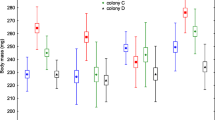Summary
-
1.
The rates at which the beesBombus vosnesenskii warmed up (Fig. 1) and expended energy depended strongly on their thoracic temperature.
-
2.
Queens of bothB. vosnesenskii andB. edwardsii regulated their thoracic temperature at 36 to 45° C during free flight at 2 to 35° C (Figs. 3 and 4).
-
3.
The ability of the smaller bees (workers) to thermoregulate in continuous flight appeared to be limited to the higher ambient temperatures (Fig. 4), and they usually did not remain in continuous free flight at ambient temperatures <10°C.
-
4.
Thoracic temperature (Fig. 5) and energy expenditure during free flight (Fig. 7) were correlated with the weight of the abdomen, as affected by honeystomach contents.
-
5.
Abdominal temperature remained near ambient temperature during warm-up (Fig. 2), and during free flight at low ambient temperatures (Fig. 3). During free flight at high ambient temperatures, on the other hand, the temperature of the abdomen approached that of the thorax.
-
6.
Body temperatures during free flight differed from those previously observed during foraging, during brood incubation and during tethered flight. Interrelationships between thoracic and abdominal temperature are discussed in terms of energy expenditure.
Similar content being viewed by others

References
Heath, J. E., Josephson, R. K.: Body temperature and singing in the katydidNeoconocephalus robustus (Orthoptera, Tettigoniidae). Biol. Bull.138, 272–285 (1970)
Heinrich, B.: Energetics of temperature regulation and foraging in a bumblebee,Bombus terricola Kirby. J. comp. Physiol.77, 49–64 (1972a)
Heinrich, B.: Physiology of brood incubation in the bumblebee queen,Bombus vosnesenskii. Nature (Lond.)239, 223–225 (1972b)
Heinrich, B.: Thermoregulation in bumblebees. I. Brood incubation byBombus vosnesenskii queens. J. comp. Physiol.88, 129–140 (1974)
Heinrich, B., Bartholomew, G. A.: An analysis of pre-flight warm-up in the sphinx moth,Manduca sexta. J. exp. Biol.55, 223–239 (1971)
Heinrich, B., Casey, T. M.: Metabolic rate and endothermy in sphinx moths. J. comp. Physiol.82, 195–206 (1973)
Heinrich, B., Kammer, A. E.: Activation of the fibrillar muscles in the bumblebee during warm-up stabilization of thoracic temperature and flight. J. exp. Biol.58, 677–688 (1973)
Kammer, A. E., Heinrich, B.: Metabolic rates related to muscle activity in bumblebees. J. exp. Biol.61, 219–227 (1974)
Krogh, A., Zeuthen, E.: The mechanism of flight preparation in some insects. J. exp. Biol.18, 1–10 (1941)
Weis-Fogh, T.: Biology and physics of locust flight. VIII. Lift and metabolic rate of flying locusts. J. exp. Biol.41, 257–271 (1964)
Author information
Authors and Affiliations
Rights and permissions
About this article
Cite this article
Heinrich, B. Thermoregulation in bumblebees. J Comp Physiol B 96, 155–166 (1975). https://doi.org/10.1007/BF00706595
Received:
Issue Date:
DOI: https://doi.org/10.1007/BF00706595



